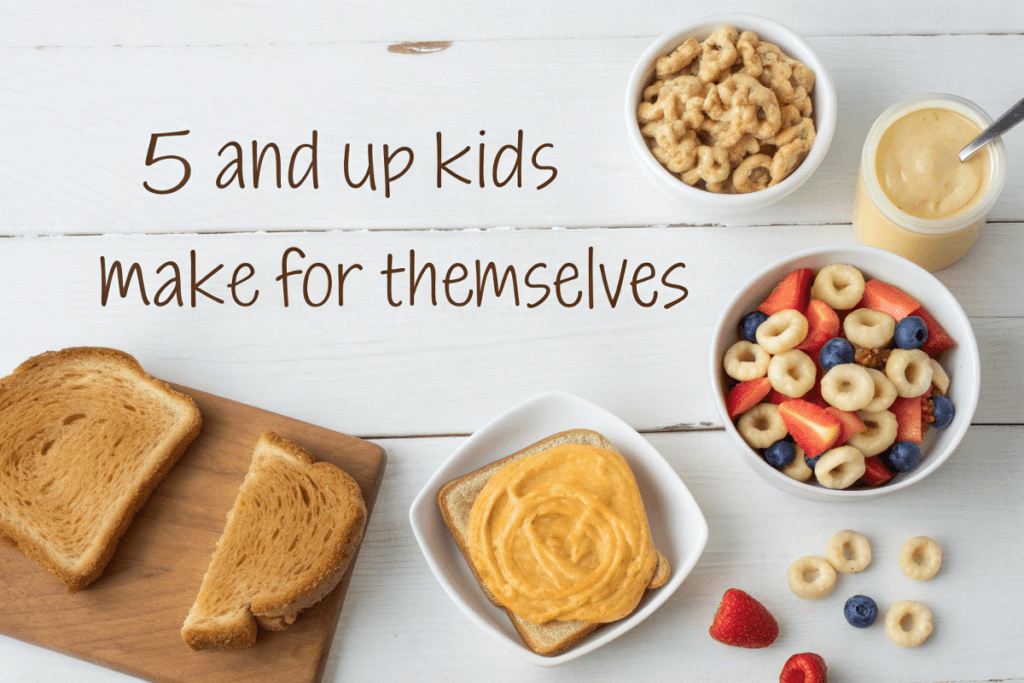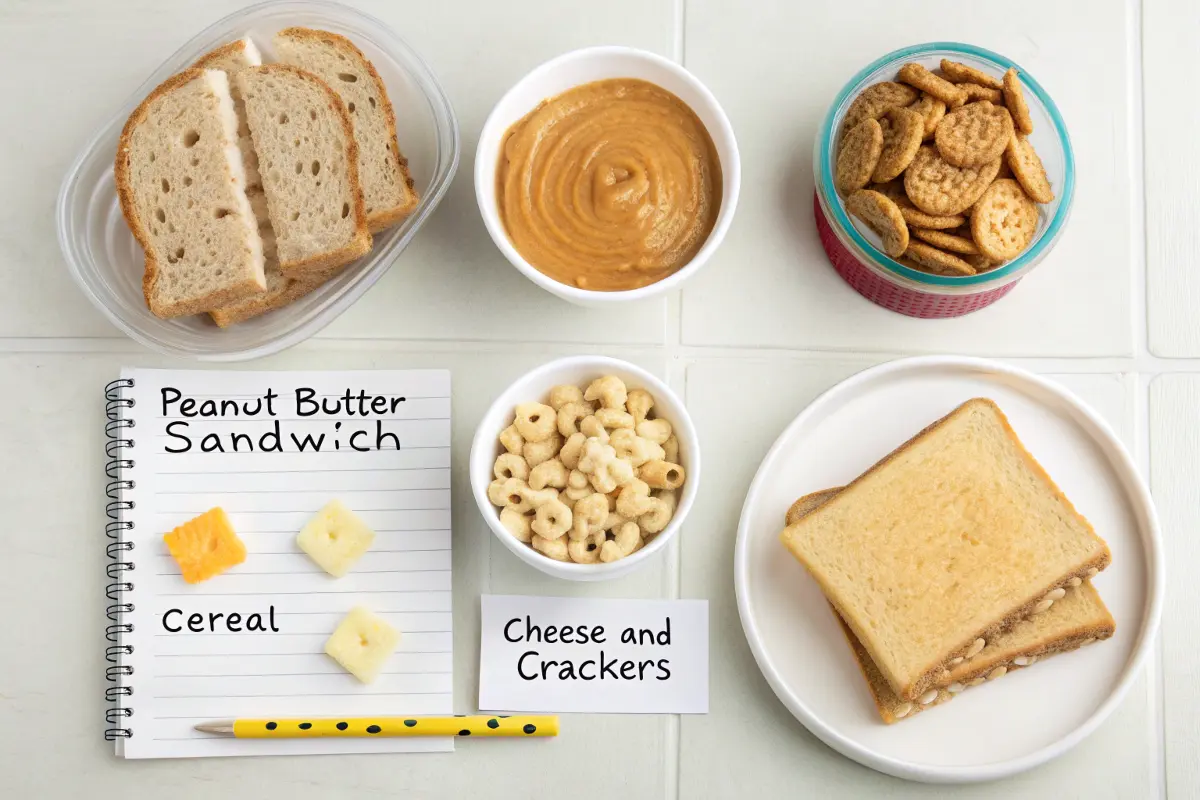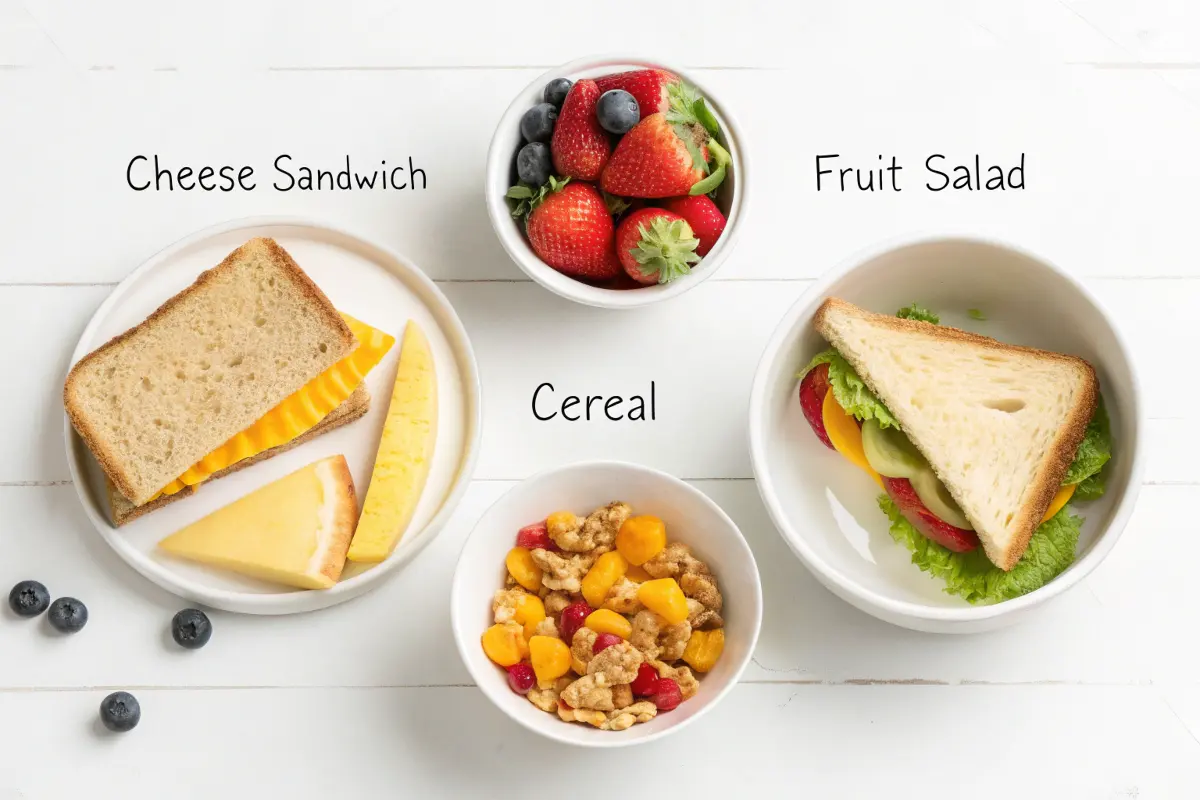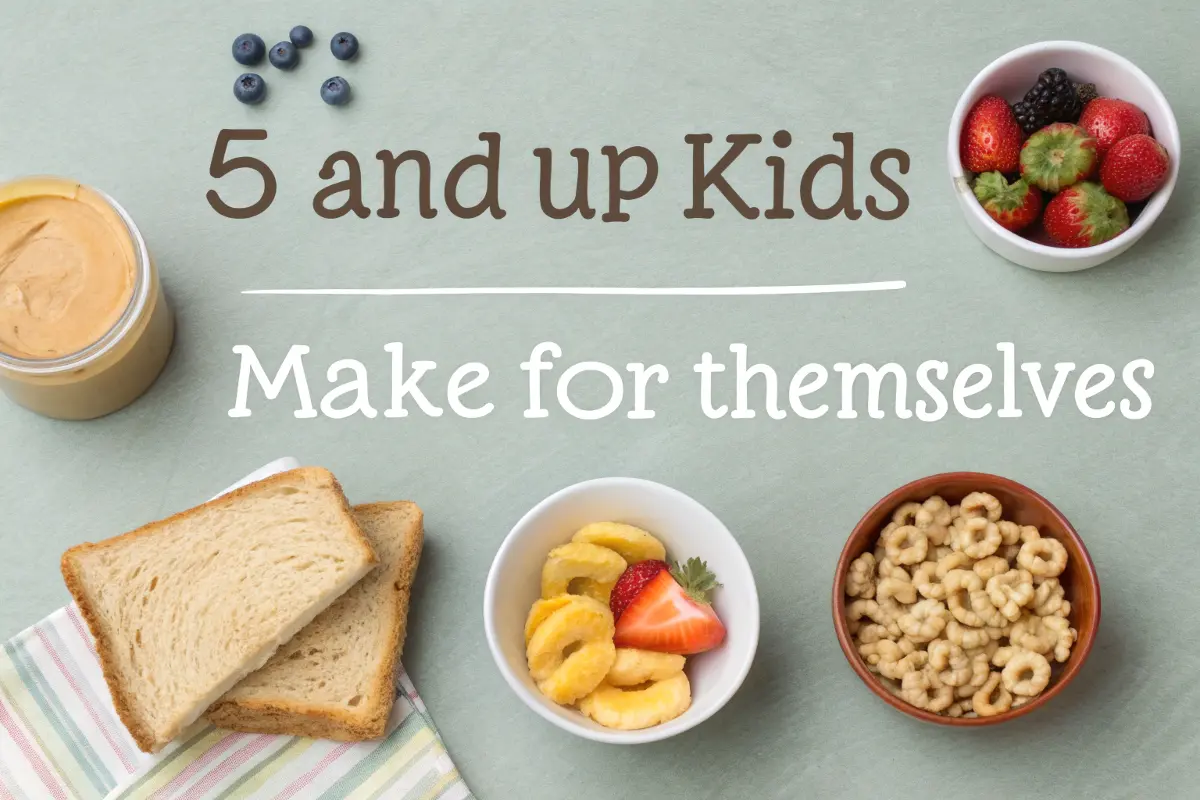Food that 5 and up kids can make for themselves is not only fun but also a great way to build confidence, independence, and healthy habits. From simple sandwiches to colorful fruit salads and creative snacks, these easy recipes empower young children to safely prepare their own meals. Whether you’re a parent or caregiver looking for safe and simple kitchen ideas, this guide offers practical dishes, safety tips, and all the benefits of involving kids in cooking early on.
Why Kids Should Learn to Cook
Cooking isn’t just a necessary life skill—it’s a creative, educational, and empowering activity. Here are some reasons to encourage kids to make their own food:
Builds Independence
Teaching kids to cook allows them to develop autonomy. When children learn to prepare their own meals, they experience a sense of accomplishment and pride. This newfound independence can translate into other areas of their lives, helping them become more self-reliant and confident.
For example:
- Morning routines: Kids can prepare simple breakfasts like toast or cereal, easing the burden on busy parents.
- After-school snacks: Instead of waiting for assistance, children can whip up quick snacks like peanut butter sandwiches or fruit salads.
- Weekend fun: Cooking projects during free time encourage productive and enjoyable activities.
Encourages Healthy Eating
When kids are involved in cooking, they’re more likely to make healthier food choices. Preparing meals allows children to see the benefits of fresh, whole ingredients and develop a better understanding of nutrition.
Some examples of healthy dishes kids can make include:
- Vegetable wraps: Combine fresh veggies and hummus in a tortilla.
- Fruit parfaits: Layer yogurt, granola, and fresh fruit for a delicious treat.
- Smoothies: Blend frozen fruits, milk, or yogurt for a nutritious drink.

By engaging with wholesome ingredients, children become more aware of what they’re putting into their bodies, fostering long-term healthy habits.
Enhances Motor Skills
Cooking is a hands-on activity that helps improve fine motor skills and hand-eye coordination. Tasks like spreading, stirring, peeling, and kneading require precision and build dexterity. For younger kids, this is especially valuable as it aids their physical development.
Key motor skill activities include:
- Spreading: Peanut butter or cream cheese on bread or crackers.
- Mixing: Stirring batter or salad dressings in a bowl.
- Peeling: Using a child-safe peeler for bananas, cucumbers, or carrots.
- Pouring: Transferring liquids like milk or juice into glasses.
Not only do these activities improve coordination, but they also make cooking more interactive and fun for kids.
Fosters Creativity
Cooking provides an excellent outlet for creativity. From designing a plate to experimenting with flavors, children can let their imaginations run wild. This creativity doesn’t just make meals more exciting—it also encourages problem-solving and critical thinking.
For instance:
- Customizing recipes: Kids can choose their favorite toppings for pizza or sandwich fillings.
- Colorful dishes: Let them arrange fruits or vegetables in fun shapes or patterns.
- Taste experiments: Encourage children to try different spices or sauces to see how they enhance flavors.
This creative freedom helps children feel a sense of ownership over their meals and motivates them to explore new foods and ideas.
Builds Teamwork and Family Bonds
Cooking together is a great way to strengthen relationships and teach kids the value of collaboration. By working alongside siblings, parents, or friends in the kitchen, kids learn to communicate effectively and divide tasks.
Ways to involve the whole family:
- Assign roles: One person chops vegetables, another measures ingredients, and someone else mixes.
- Share meal ideas: Allow each family member to suggest a recipe for the week.
- Celebrate successes: Sit down together to enjoy the meal everyone contributed to.
These shared experiences create lasting memories and foster a positive environment where kids feel supported.
Provides Lifelong Skills
Learning to cook is an essential life skill that benefits children well into adulthood. Early exposure to cooking lays the foundation for self-sufficiency and boosts their confidence in the kitchen. By mastering simple recipes as kids, they’re better prepared to handle more complex meals in the future.
Some foundational skills to teach include:
- Basic knife skills: Using a child-safe knife for cutting soft foods like bananas or cucumbers.
- Following recipes: Understanding measurements and sequential steps.
- Cooking techniques: Introducing simple methods like boiling pasta or scrambling eggs with supervision.

Promotes Responsibility and Ownership
When kids prepare their own meals, they gain a sense of responsibility. They learn the importance of cleaning up after themselves and managing their time effectively in the kitchen. This accountability extends to other areas of life, teaching children to take pride in their contributions and efforts.
Tips for fostering responsibility:
- Encourage cleanup: Teach kids to wash utensils and wipe counters after cooking.
- Set expectations: Give them specific tasks to complete, such as setting the table or organizing ingredients.
- Praise effort: Recognize their hard work, regardless of the outcome, to build confidence.
Why Start Young?
Introducing kids to cooking at an early age helps build habits and skills that last a lifetime. It’s easier to develop a love for cooking when it’s associated with fun and positive experiences. Plus, younger children are often more open to trying new foods when they’ve had a hand in preparing them.
Key takeaways:
- Start with age-appropriate tasks and gradually introduce more complex activities.
- Focus on the process rather than the final product to keep the experience enjoyable.
- Make cooking a regular part of their routine to reinforce learning.
By encouraging kids to cook, you’re giving them tools to succeed both in and out of the kitchen. It’s a win-win for the whole family!
Safety Tips for Kids in the Kitchen
Before jumping into recipes, ensure the kitchen is a safe space for kids:
Supervise as Needed
Stay nearby to guide kids through tricky steps or tools. While kids can perform many tasks independently, having an adult present ensures they can ask for help when needed. Your presence also gives them confidence.
Use Child-Safe Tools
Invest in tools specifically designed for young chefs. These include:
- Kid-friendly knives with rounded tips
- Vegetable peelers with safety guards
- Non-slip mixing bowls
- Silicone spatulas and tongs
Child-safe tools reduce the risk of injury while letting kids develop essential kitchen skills.
Teach Basic Hygiene
Good hygiene is critical in the kitchen. Make handwashing a priority before, during, and after cooking. Remind kids to:
- Wash hands with soap and water for at least 20 seconds.
- Avoid touching their face while handling food.
- Use clean utensils and equipment.
Avoid Hot Surfaces
Focus on no-cook recipes or those requiring minimal heat to prevent burns. For recipes that involve hot surfaces, use appliances like:
- Microwaves (under supervision)
- Toaster ovens (with adult guidance)
- Electric griddles set to low heat
Teach kids about the dangers of stovetops and ovens, emphasizing why it’s essential to stay cautious around heat sources.
Simplify the Workspace
A clutter-free kitchen is a safer kitchen. Ensure kids can access ingredients and tools without climbing or reaching precariously. Set up a designated workspace with:
- Pre-measured ingredients
- Tools within arm’s reach
- A stable surface for mixing or assembling food
Keeping things organized prevents accidents and makes the cooking process smoother for young chefs.
Practice Knife Safety
Introduce knife skills gradually. Start with:
- Plastic or child-safe knives
- Soft foods like bananas or cheese
- Simple cutting techniques (e.g., slicing or chopping)
Always demonstrate proper knife handling and emphasize the importance of keeping fingers out of the cutting path.
Use Visual Cues
Label drawers and cabinets with pictures or words to help kids locate items easily. Visual cues minimize confusion and make the kitchen more user-friendly for young learners.
Create a Safe Zone
Designate a specific area in the kitchen where kids can work without interruption. Keep this zone free of hazards like hot pots, sharp objects, or heavy equipment. This safety-first approach ensures kids feel comfortable while exploring their culinary skills.
Encourage Communication
Teach kids to communicate any issues or uncertainties while cooking. For instance:
- “This knife feels too sharp. Can you help?”
- “Is this bowl okay for mixing?”
Open communication fosters a collaborative environment where kids feel supported and safe.
Celebrate Safety Milestones
Acknowledge progress as kids master safety habits. Whether it’s washing their hands without reminders or successfully using a child-safe knife, celebrating milestones reinforces good practices.
By ensuring a secure and organized kitchen environment, kids can confidently explore cooking while staying safe. These precautions set the stage for a positive and enjoyable culinary journey.

Easy Recipes for Kids Aged 5 and Up
1. No-Cook Sandwiches
Sandwiches are a classic option that kids can customize to their liking. Here’s how they can make one:
Ingredients:
- Bread slices (whole wheat or white)
- Peanut butter or almond butter
- Jelly, honey, or banana slices
Instructions:
- Lay the bread slices on a clean surface.
- Spread peanut butter on one slice and jelly on the other using a butter knife.
- Put the slices together and cut into triangles.
2. Fruit and Yogurt Parfait
A colorful parfait is as fun to make as it is to eat.
Ingredients:
- Yogurt (vanilla or plain)
- Mixed fruits (berries, banana slices, or mango chunks)
- Granola
Instructions:
- In a clear cup, layer yogurt, fruits, and granola.
- Repeat layers until the cup is full.
- Top with a drizzle of honey if desired.
3. Mini Pita Pizzas
Kids can get creative with toppings while assembling these mini pizzas.
Ingredients:
- Mini pita bread
- Tomato sauce or pizza sauce
- Shredded cheese
- Toppings like olives, bell peppers, or pepperoni
Instructions:
- Spread sauce over the pita bread.
- Sprinkle cheese on top.
- Add toppings as desired.
- Heat in a microwave or toaster oven for a few minutes until the cheese melts (adult supervision may be required).
4. Veggie and Cheese Roll-Ups
These roll-ups make a great snack or lunchbox addition.
Ingredients:
- Flour tortillas
- Cream cheese
- Shredded carrots, spinach, or cucumber slices
Instructions:
- Spread cream cheese evenly over the tortilla.
- Layer with veggies.
- Roll the tortilla tightly and slice into bite-sized pieces.
5. Trail Mix
A DIY trail mix is perfect for a quick snack.
Ingredients:
- Nuts (if there are no allergies)
- Dried fruits
- Pretzels
- Mini chocolate chips or candies
Instructions:
- Combine all ingredients in a large bowl.
- Portion into small snack bags.
6. Smoothies
Smoothies are nutritious, delicious, and easy to prepare.
Ingredients:
- Frozen fruits (berries, mango, or banana)
- Milk or yogurt
- A drizzle of honey
Instructions:
- Place all ingredients in a blender.
- Blend until smooth.
- Pour into a cup and enjoy.
Tips to Encourage Kids in the Kitchen
- Make It Fun: Turn cooking into a game or learning activity.
- Praise Their Efforts: Celebrate their creations, even if it’s not perfect.
- Let Them Choose Recipes: Allowing kids to pick what they make boosts enthusiasm.
- Teach Them Measurements: Show them how to measure ingredients to sneak in some math practice.
FAQs About Food that 5 and up kids can make for themselves
1. What are easy foods kids can make?
Kids can make simple dishes like sandwiches, fruit salads, yogurt parfaits, and smoothies with minimal supervision.
2. At what age can kids start cooking?
Children as young as five can begin with no-cook recipes or tasks like spreading, mixing, and assembling.
3. How can I ensure my child stays safe while cooking?
Supervise closely, provide kid-friendly tools, and focus on no-cook or microwave-only recipes.
4. What skills do kids learn by cooking?
Cooking enhances motor skills, creativity, math skills (measuring), and a sense of independence.
5. What are some good breakfast ideas for kids to make?
Easy options include cereal with milk, toast with spreads, or fruit and yogurt parfaits.
6. Are there recipes kids can make without adult supervision?
Yes, simple snacks like trail mix or peanut butter sandwiches don’t require adult help.
7. How do I keep my picky eater interested in cooking?
Let them pick ingredients or recipes they’re excited about, and encourage them to taste as they cook.
8. What tools are safe for kids to use in the kitchen?
Child-safe knives, peelers, and silicone spatulas are great tools for young chefs.
9. How can I make cooking fun for kids?
Incorporate games, storytelling, or themed meals to make the experience enjoyable.
10. Why is cooking important for kids?
Cooking teaches essential life skills, promotes healthy eating, and builds confidence.
Conclusion
Teaching kids aged five and up to prepare their own meals is a rewarding journey. It’s about more than just food; it’s an opportunity to instill lifelong skills, foster creativity, and strengthen family bonds. Start with simple, fun recipes and watch their confidence soar.
Ready to try these kid-friendly recipes? Share your favorites or let us know how your little chef’s creations turn out in the comments below. Don’t forget to check out more resources for family-friendly cooking ideas!

